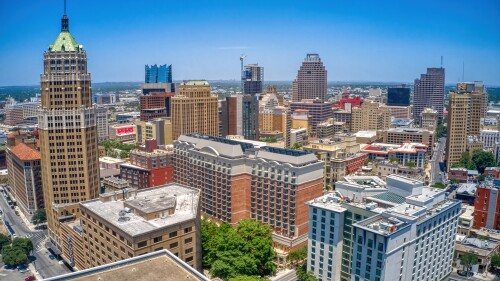By Terence O’Connell and Wes Guckert
The automobile is the backbone of the modern economy, yet its negative repercussions on public health, the environment, and land use patterns cannot be underestimated. Each year, car accidents kill more than 32,000 Americans and injure 2 million. Car and truck emissions account for the majority of urban air pollution. And while personal vehicles provide mobility to those who can afford and are able to drive them, more vulnerable groups—the poor, elderly, and disabled—often rely on inconsistent public transportation systems to get around.
The promise to solve these problems has stirred excitement about autonomous vehicles. Fully autonomous vehicles are not merely an incremental advance in transportation technology; they represent a transportation revolution matched only by the automobile’s replacement of the horse and buggy. Not to be confused with semi-autonomous vehicles like the Tesla, fully autonomous vehicles do not need a steering wheel because they operate independently of a human driver. Google’s autonomous vehicles have logged over 1 million miles traveled on U.S. streets with only one minor accident blamed on the vehicle itself.
Fully autonomous vehicles will reshape cities in the same way the automobile shaped nearly every aspect of the built environment. While investors and industry participants widely recognize the impact autonomous vehicles will have on the $2 trillion automotive industry, less attention has been paid to their impact on real estate, which encompasses $25 trillion in physical assets, nearly all of which were designed to accommodate the car. The economic and technological feasibility of autonomous vehicles has finally arrived, and the coming decades will be spent adapting the regulatory and infrastructure systems to harness this technology.
The End of a Love Affair with Cars
American households spend an average of $9,000 per year on expenses for personal vehicles, representing 17 percent of average household spending. These expenses include car payments, gasoline, insurance, maintenance, and taxes; as a result, Americans spend 50 to 80 cents per mile (31–50 cents per km) to travel by car.
On average, cars are used for only 5 percent of their lifetime and sit idle for the other 95 percent. This extreme underuse has created large opportunities for ride- and car-sharing companies like Lyft, Uber, and Car2Go, which are investing aggressively in fully autonomous vehicles. Autonomous vehicles have the potential to maximize the use of vehicles while also removing the largest marginal cost: the driver. These “mobility as a service” companies will be able to deliver mobility with fully autonomous vehicles at 15 to 30 cents per mile (9–19 cents per km), according to ARK Invest, representing an annual household savings of $6,000.
The deployment of fully autonomous vehicles by such companies will contribute to a massive decline in car ownership and allow passengers to take advantage of the lower marginal cost of sharing an autonomous vehicle.
The shift to shared autonomous vehicles could result in significantly fewer vehicles on roads and parking lots because one shared vehicle could replace more than five private vehicles. A recent study found that Ann Arbor, Michigan, could meet all local resident transportation demand by replacing 120,000 privately owned cars with 18,000 shared autonomous vehicles.
Un-Paving Our Cities
Transportation has always shaped land use. As cars became the dominant mode of transport, cities expanded highways, roads, and parking lots to accommodate them. The United States now has more than 800 million parking spaces—nearly four parking spaces per vehicle.
As it shuttles from one fare to another without parking, an autonomous vehicle would require far fewer parking spots than a privately owned car. Researchers estimate that a fleet of shared autonomous vehicles in urban areas could achieve daytime use rates near 70 percent. An autonomous vehicle–only street might have four lanes of traffic during the day, but two lanes devoted to parking at night. As a result, analysts project that long-term demand for parking could fall by over 90 percent. This drop, coming in 5 percent annual declines, could free up 40 million parking spaces for other land uses each year.”
Roads, highways, and parking consume over 40 percent of urban land area, a figure that climbs as high as 65 percent in places like Houston’s central business district. Of this land dedicated to to cars, half is used for parking and the other half for roads. Autonomous vehicles will increase the efficiency of roadways by requiring significantly less road space than cars today. By traveling closer together and in narrower lanes, autonomous vehicles could support the same traffic volume as human-driven cars on one-quarter of the road space, by some estimates. This, too, would free up land for more productive uses, such as green space or affordable housing.
Retail Redefined
Retail properties are uniquely exposed to the coming transportation revolution. Online sales are already eating into traditional retailer business, but still only represent 8 percent of total retail sales. The major remaining hurdle for online sales has been the cost and speed of home deliveries.
The grocery business is a prime example of an industry that has been largely immune to e-commerce as a result of the obstacles to scaling up home delivery of everyday consumer goods. Autonomous delivery vehicles could solve this problem by providing fast, cheap, door-to-door delivery. Consumers could order a gallon of milk by smartphone and receive it within an hour. Neighborhood grocery stores will certainly continue to exist, but a large portion of the business could move to online delivery.
As online sales become just as cheap and convenient as in-person shopping, the demand for storefront retail space will decline. This drop in demand would arrive at a time when the United States has 23 square feet (2.1 sq m) of shopping center space per capita compared with ten square feet (0.93 sq m) in Australia and five square feet (0.46 sq m) in the United Kingdom.
Burdened with oversupply and declining demand, many U.S. retail centers will need to be redeveloped for alternative uses. Among all land uses retail properties typically have the most parking relative to their size: for example, a 1 million-square-foot (93,000 sq m) mall might have 5,000 parking spaces. Use of autonomous vehicles will cut this parking demand dramatically—perhaps by 30 percent, which would free up 1,500 spaces, roughly a dozen acres (5 ha), for redevelopment.
Successful retail centers will need to focus on experiential retail. Most large retail properties today are designed to provide convenient parking for shoppers at the expense of pedestrian appeal. Changing single-story big-box retailers with surface parking lots into attractive, walkable environments could prove difficult, leaving those unable to make the transition obsolete.
Distribution Centers Urbanize and Multifamily Properties Adapt
Distribution centers today typically are located within one day’s drive of the storefront retail they serve. But as more retail sales move online and consumers demand real-time deliveries, distribution centers will need to move into urban areas. A patchwork of smaller, local distribution centers will be needed to serve thousands of autonomous delivery vehicles making home deliveries. Ideally, these centers will have purpose-built loading docks compatible with autonomous delivery vehicles of varying sizes. As demand for urban distribution centers increases, the demand for exurban distribution centers likely will decline.
And as residential properties receive even more deliveries, new systems will be needed to manage and deliver packages. Multifamily properties are already struggling to manage the flow of packages as residents do more of their shopping online. Properties are running out of lobby space to hold packages and lack the staff to deliver packages to residents. Multifamily properties could soon install loading locks compatible with the autonomous delivery vehicles. The final step could be a direct connection of the vehicles with each unit.
Conclusion
As Bill Gates noted, “We always overestimate the change that will occur in the next two years and underestimate the change that will occur in the next ten years.” In the next two years, we will probably only see cracks in traditional business models and small autonomous vehicle pilot projects in cities. But cities will certainly look different in ten years as a result of this transportation revolution.
Terence O’Connell is associate vice president of acquisitions and management at CCM Real Estate in Washington, D.C. Wes Guckert is president of the Traffic Group, a transportation consulting firm in Baltimore, and chair of the ULI Public Development and Infrastructure Council. They are members of a ULI member-led working group dedicated to expanding knowledge of autonomous vehicles and their potential impact on the built environment. They can be reached at [email protected] and [email protected].





